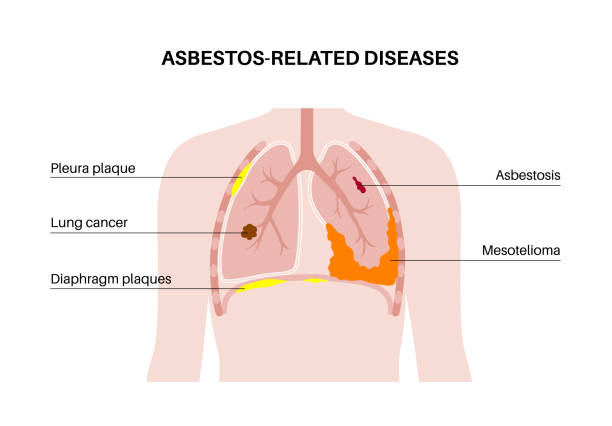While asbestos itself is a material and not a disease, the medical conditions resulting from its exposure require specific approaches.
This article explores the various health complications associated with asbestos, outlines the current options available for these conditions, and discusses the importance of early detection and medical intervention.
Can Asbestos Be Cured?

Asbestos itself is not a condition that can be “treated” as it is a group of naturally occurring mineral fibers used in various industrial products due to their resistance to heat, fire, and chemicals.
However, exposure to asbestos can lead to serious health conditions, including asbestosis, lung cancer, and mesothelioma, which are conditions that require medical assistance.
Health management effectiveness varies and can depend on the stage at which the disease is diagnosed and the overall health of the individual. Regular medical check-ups and early detection can improve the management of these conditions.
Asbestos-Related Diseases

Asbestos-related diseases primarily affect the lungs and the membrane that surrounds the lungs. Here is a detailed explanation of the main conditions caused by exposure to asbestos materials:
Asbestosis
A chronic lung disease is caused by inhaling asbestos dust, which leads to scarring (fibrosis) of lung tissue. Symptoms often include shortness of breath, persistent dry cough, chest tightness, and in severe cases, finger clubbing.
It’s a progressive condition with no cure, typically managed by treating symptoms and supporting lung function.
Lung Cancer
Inhaling asbestos fibers can also lead to lung cancer, particularly at the sites where the fibers are lodged in the lung tissues.
Smoking significantly increases this risk. Symptoms may not appear until many years after the exposure and can include coughing, chest pain, weight loss, and shortness of breath.
Health management varies depending on the stage of cancer and may include surgery, chemotherapy, and radiation therapy.
Mesothelioma
This rare form of cancer and asbestos-related disease develops in the lining of the lungs (pleura) or abdomen (peritoneum). It is directly linked to asbestos exposure and can take 20-50 years to develop after inhalation.
Symptoms include chest pain, shortness of breath, and abdominal swelling.
These conditions are all serious and highlight the importance of protective measures and regulations in environments where asbestos exposure is possible.
Early detection can improve outcomes in some cases, particularly with cancers associated with asbestos.
Managing Asbestos-Related Diseases

Managing asbestos-related diseases involves a combination of approaches tailored to the specific condition and its severity. Here’s a concise overview of management strategies for the main asbestos-related diseases:
Asbestosis Management
Pulmonary Rehabilitation
This program involves structured exercise, education, and lung function tests to enhance physical and emotional health.
Exercises are tailored to help strengthen the muscles and relieve symptoms while breathing techniques like pursed-lip breathing can help manage breathlessness.
Oxygen Therapy
Used when blood oxygen levels are low. It can significantly improve quality of life, help with sleep, and reduce complications from low oxygen levels.
Medication
Bronchodilators are prescribed to relax and open the air passages in the lungs, improving airflow. Mucolytics help break down mucus so it’s easier to clear from the lungs, reducing congestion and infection risk.
Lung Cancer Management
Surgical Intervention
Involves a lung transplant or removing just the tumor depending on the tumor’s size, location, and extent. Surgery is most effective in early-stage non-small cell lung cancer.
Chemotherapy and Radiation Therapy
Chemotherapy may be administered before surgery (to shrink tumors) or after (to eliminate residual cancer cells).
Radiation may target the remaining cancer cells post-surgery or be used as a standalone option for those who are not surgical candidates.
Targeted Therapy and Immunotherapy
These therapies are selected based on the genetic markers of cancer cells. Targeted therapy drugs specifically disrupt cancer growth mechanisms with fewer side effects, while immunotherapy enhances the body’s natural defenses to fight cancer.
Mesothelioma Management
Multimodal Therapy
The combination of surgery, chemotherapy, and radiation aims to remove or kill cancer cells and reduce tumor size, tailored according to the mesothelioma’s stage and location.
Surgery could range from debulking (removing as much tumor as possible) to more radical procedures like a pleurectomy.
Clinical Trials
Provide access to new and potentially effective treatments under evaluation. They are vital for patients with limited standard options.
General Management Strategies

Smoking Cessation
Smoking is a significant risk factor for the progression of lung diseases and can interfere with the efficacy of options.
Quitting smoking slows disease progression and decreases the risk of developing secondary respiratory infections.
Regular Monitoring and Check-ups
Essential to track the progression of the disease and its effectiveness. This includes regular imaging tests and pulmonary function tests to monitor lung capacity and function.
Vaccinations
Critical to reduce the risk of respiratory infections. Vaccines like those for influenza and pneumococcal pneumonia are recommended as these infections can be particularly severe in patients with compromised lung health.
These strategies are integrated within a patient’s health plan to manage symptoms effectively, improve quality of life, and extend survival.

